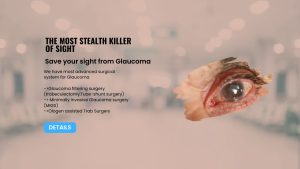OPENING TIME: MON-SAT (8:00AM-8:00PM*)SUN:8:00AM-1:00PM
Glaucoma
Glaucoma is a group of eye diseases characterized by damage to the optic nerve, which is crucial for vision. This damage is often associated with increased pressure within the eye (intraocular pressure or IOP). If left untreated, glaucoma can lead to progressive and irreversible vision loss, making it one of the leading causes of blindness worldwide.
Types of Glaucoma
Primary Open-Angle Glaucoma (POAG)
- The most common type of glaucoma.
- Occurs when the drainage canals in the eye become clogged over time, leading to increased eye pressure.
- Often develops slowly and painlessly, making regular eye exams crucial for early detection.
Angle-Closure Glaucoma
- Occurs when the iris bulges forward, narrowing or blocking the drainage angle formed by the cornea and iris.
- Can be chronic (progressing slowly) or acute (developing suddenly with symptoms like severe pain and sudden vision loss).
- Acute angle-closure glaucoma is a medical emergency and requires immediate attention.
Normal-Tension Glaucoma
- Optic nerve damage occurs despite normal intraocular pressure.
- The exact cause is not well understood but may involve poor blood flow to the optic nerve.
Secondary Glaucoma
- Results from another eye condition or disease, such as uveitis, eye trauma, or steroid use.
- Treatment focuses on addressing the underlying cause along with managing IOP.
Congenital Glaucoma
- A rare form present at birth, caused by abnormal development of the eye’s drainage system.
- Requires early surgical intervention to prevent vision loss.
Causes and Risk Factors
- Increased Intraocular Pressure (IOP): The most significant risk factor for optic nerve damage.
- Age: People over 60 are at higher risk.
- Family History: Genetics play a role; having a family member with glaucoma increases risk.
- Medical Conditions: Conditions like diabetes, high blood pressure, and heart disease.
- Ethnicity: Higher prevalence in African Americans, Hispanics, and Asians.
- Eye Injuries: Trauma to the eye can cause secondary glaucoma.
- Prolonged Steroid Use: Both oral and topical steroids can increase IOP.
Symptoms
- Primary Open-Angle Glaucoma: Often asymptomatic in the early stages. Peripheral vision loss is usually the first noticeable symptom.
- Acute Angle-Closure Glaucoma: Symptoms include severe eye pain, headache, nausea, vomiting, blurred vision, and seeing halos around lights.
- Normal-Tension Glaucoma: Similar to POAG but without elevated IOP.
- Secondary and Congenital Glaucoma: Symptoms depend on the underlying cause and can include any combination of the above.
Diagnosis
Early detection through regular eye exams is crucial, especially for those at higher risk. Diagnostic procedures include:
- Tonometry: Measures intraocular pressure.
- Ophthalmoscopy: Examines the optic nerve for signs of damage.
- Perimetry: Visual field test to check for areas of vision loss.
- Gonioscopy: Inspects the drainage angle to differentiate between open and closed-angle glaucoma.
- Pachymetry: Measures corneal thickness, which can affect IOP readings.
- Optical Coherence Tomography (OCT): Imaging technology that provides detailed images of the optic nerve and retinal nerve fiber layer.
Treatment Options
Treatment aims to lower IOP to prevent further optic nerve damage. Options include:
Medications
- Prostaglandin Analogs: Increase outflow of aqueous humor (fluid) to lower IOP (e.g., latanoprost, bimatoprost).
- Beta Blockers: Reduce production of aqueous humor (e.g., timolol).
- Alpha Agonists: Decrease aqueous humor production and increase outflow (e.g., brimonidine).
- Carbonic Anhydrase Inhibitors: Reduce aqueous humor production (e.g., dorzolamide).
- Rho Kinase Inhibitors: Increase fluid outflow through the trabecular meshwork (e.g., netarsudil).
Laser Therapy
- Selective Laser Trabeculoplasty (SLT): Enhances drainage through the trabecular meshwork in POAG.
- Laser Peripheral Iridotomy: Creates a small hole in the iris to improve fluid outflow in angle-closure glaucoma.
- Cyclophotocoagulation: Reduces fluid production by targeting the ciliary body.
Surgery
- Trabeculectomy: Creates a new drainage path for aqueous humor.
- Glaucoma Drainage Devices: Implants that help drain excess fluid.
- Minimally Invasive Glaucoma Surgery (MIGS): Procedures that improve fluid outflow with less trauma than traditional surgeries.
Preventive Measures
While glaucoma cannot be prevented, the risk of vision loss can be minimized with:
- Regular Eye Exams: Especially important for those over 40 or with risk factors.
- Healthy Lifestyle: Maintain a balanced diet, exercise regularly, and avoid smoking.
- Eye Protection: Use protective eyewear to prevent injuries.
- Managing Health Conditions: Control diabetes, high blood pressure, and other related conditions.
Living with Glaucoma
Managing glaucoma involves a lifelong commitment to treatment and regular follow-ups. Tips for living with glaucoma include:
- Medication Adherence: Take prescribed eye drops and medications consistently.
- Regular Monitoring: Keep all follow-up appointments to monitor IOP and optic nerve health.
- Visual Aids: Use magnifiers, better lighting, and other aids to manage vision changes.
- Support Groups: Join groups for emotional support and practical advice.
Why Choose Dr. Aswini’s Naitrika Superspeciality Eye Care for Glaucoma Management?
- Expertise: Highly trained ophthalmologists specializing in glaucoma care.
- Advanced Technology: State-of-the-art diagnostic and treatment tools.
- Comprehensive Care: From diagnosis to long-term management and surgery.
- Patient-Centered Approach: Personalized treatment plans tailored to individual needs.
- Support Services: Vision rehabilitation and patient education programs.

